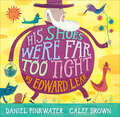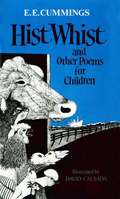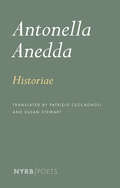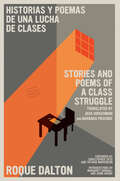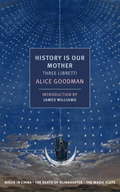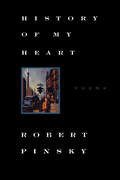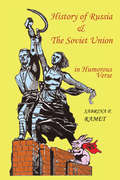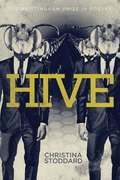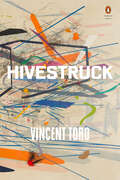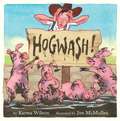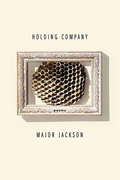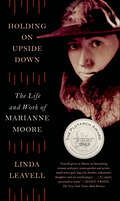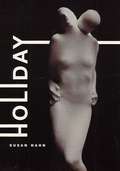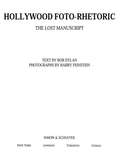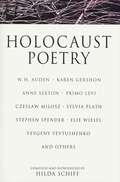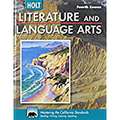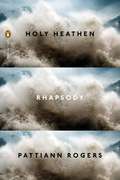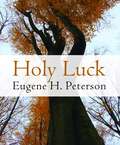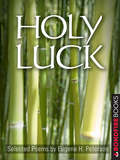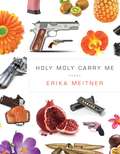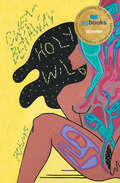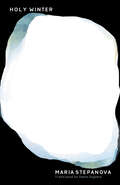- Table View
- List View
His Shoes Were Far Too Tight: Poems by Edward Lear
by Edward Lear Daniel Pinkwater Calef BrownRenowned author Daniel Pinkwater and best-selling poet and artist Calef Brown team up to champion the ridiculous! These endlessly fascinating and imaginative poems are as fresh and delightful today as they were when Edward Lear wrote them more than a hundred years ago--from "The Owl and the Pussycat" to "The Pobble Who Has No Toes." This charming book proves that, sometimes, there's nothing children need more than a healthy dose of nonsense!
Hist Whist: And Other Poems for Children
by E. E. CummingsNow children can claim for their very own the puddle-wonderful (mudluscious) world where buds know better than books don't grow, where little itchy mousies with scuttling eyes rustle and run and hidehidehide, and the ree ray rye roh rowster shouts rawrOO. Cummings's poetry more than that of any other major American poet keeps faith with childhood. These twenty poems were selected by him and published privately in 1962. Hist Whist combines the original twenty poemes enfantins with the first appearance of the beautiful and evocative line drawings of the young California artist David Calsada. His sensitive pen has captured the spirit of Cummings's poems in its detailed rendering of a world that only poets and children can see.
Historiae
by Antonella AneddaPoems between natural and human history, private life and death, and about the crises of our century, from an acclaimed Italian poet.Tacitus, the brooding historian of the Roman Empire, supplies the title of Antonella Anedda&’s Historiae, in which she grapples with a legacy of Mediterranean displacement and violence that stretches from antiquity to the present day. Anedda writes about the aftermath of centuries of colonization, about the ongoing European immigration crisis, and about the wild Sardinian archipelago of La Maddalena and the teeming Roman neighborhood of Trastevere—places between which she has divided her life—in a wonderfully various collection where poems of community frame poems of private life, among them a moving elegy for her mother. With wit, insight, and economy, Anedda reminds us that history is plural and that our perspectives, too, are constituted by pluralities—by events both present and past, both world-shaking and exquisitely mundane.
Historias y poemas de una lucha de clases / Stories and Poems of a Class Struggle
by Roque Dalton&“The revolutionary the dictatorship couldn&’t kill, the trickster poet favored by the gods.&” —Ben Ehrenreich, author of The Way to Spring: Life and Death in PalestinePoems of revolution by one of Latin America&’s most beloved poets One of Latin America&’s greatest poets, Roque Dalton was a revolutionary whose politics were inseparable from his art. Born in El Salvador in 1935, Dalton dedicated his life to fighting for social justice, while writing fierce, tender poems about his country and its people. In Poemas clandestinos / Stories and Poems of a Class Struggle, he explores oppression and resistance through the lens of five poetic personas, each with their own distinct voice. These poems show a country caught in the crosshairs of American imperialism, where the few rule the many and the many struggle to survive—and yet there is joy and even humor to be found here, as well as an abiding faith in humanity. In striking, immediate, exuberantly inventive language, Dalton captures the ethos of a people, as stirring now as when the book was first published nearly forty years ago. &“I believe the world is beautiful,&” he writes, &“and that poetry, like bread, is for everyone.&”
History is Our Mother: Nixon in China, The Death of Klinghoffer, The Magic Flute
by James Williams Alice GoodmanThe first appearance of Alice Goodman's two internationally-renowned and controversial libretti, alongside one of her masterful translations.An NYRB Classics Original Nixon in China and The Death of Klinghoffer played a crucial role in bringing opera back to life as a contemporary art form, and they have been popular—and, in the case of Klinghoffer, highly controversial—ever since they were first staged by the director Peter Sellars in the eighties and nineties. Both operas were conceived from the start as collaborations between composer and writer, and their power is due as much to the dazzlingly constructed and deeply felt libretti of the poet Alice Goodman as they are to John Adams’s music. Nixon in China is a story, at once heroic, comic, and unnerving, of men and women making history and of their different conceptions of what history is and what it means to makes it. Klinghoffer, by contrast, has at its center the tragedy of an innocent man condemned at the cost of his life to play a part in history. History Is Our Mother, which takes its title from a line sung by the title character in Nixon in China, brings Goodman’s two libretti together for the first time in book form. Included alongside Goodman’s no less inspired translation of Emanuel Schikaneder’s famous libretto to The Magic Flute, these vivid dramas of character and searching meditations on fate are here revealed as among the most original, ambitious, and accomplished poetic achievements of our time.
History of My Heart: Poems
by Robert PinskyHistory of My Heart, winner of the William Carlos Williams Prize, first appeared in 1984. In The New Republic, J.D. McClatchy called it "one of the best books of the past decade." It is Pinsky's third volume of poems--and an ideal introduction to the work of a vital and original contemporary American poet.
History of Russia & the Soviet Union in Humorous Verse
by Sabrina P. RametThe dramatic history of Russia proves fertile ground for laughter in this volume of humorous verse by the author of Pets of the Great Dictators.Sabrina P. Ramet is a serious academic with a seriously funny side. She has made major contributions to European history with her scholarly work on the former Yugoslavia. But her most unique contribution may be the well-informed and wackily executed poems in this volume. No Russian is safe from Sabrina’s hammer-and-sickle wit. Even the most fearsome and formidable—Lenin, Stalin, Peter the Great, and many others—are shown to be buffoons in this collection of satirical poems as dry as a straight shot of vodka.
Hitchcock Blonde: A Cinematic Memoir
by Sharon DolinA heady cocktail of sex and trauma, refracted through the lens of ten of Alfred Hitchcock's iconic movies.Imagine an episodic memoir that braids together insights about Alfred Hitchcock's movies with the narrative of a woman's life: scenes of growing up in Brooklyn in the sixties and seventies as the daughter of a schizophrenic mother and a traveling salesman father, adolescent sexual traumas, and adult botched marriages and relationships— all refracted through the lens of ten of Alfred Hitchcock's iconic movies.In each chapter, the narrator—an award-winning poet—trains her idiosyncratic lens on a different film and then onto the uncanny connections they conjure up from her own life. A singular cliffhanging tale, reminiscent in style of Azar Nafisi's Reading Lolita in Tehran and Helen Macdonald's H Is for Hawk.
Hive
by Christina StoddardHive is a remarkable debut collection of poems about brutality, exaltation, rebellion, and allegiance. Written in the voice of a teenage Mormon girl, these poems chronicle an inheritance of daily violence and closely guarded secrets. A conflicting cast of recurring characters-best friends, sisters, serial killers, and the ominous Elders-move through these poems as the speaker begins to struggle with the widening gulf between her impulse toward faith and her growing doubts about the people who claim to know God's will. Ultimately she must confront what it means to believe and what it costs to save ourselves.
Hivestruck (Penguin Poets)
by Vincent Toro&“Virtuosic . . . one of our most talented and daring poets . . . Hivestruck crackles with Toro&’s critical vision and dazzling wit.&” —John Keene, National Book Award-winning author of Punks: New and Selected PoemsA poet whose work has focused on Puerto Rican and Latinx history and identity poses the question of what makes us human, and technology&’s part in that process, through a decolonial lensVincent Toro&’s third collection of poetry is a work of Latinxfuturism that confronts the enigmatic and paradoxical relationship human beings have with technology. The poems are a tapestry of meditations on social media and surveillance culture, satires on science fiction and the space race, interrogations of artificial intelligence, cyborg economics, and biohacking, and tributes to women and queer and BIPOC people who have contributed and are contributing to human survival and progress in a technology obsessed world.
Hockey Haiku: The Essential Collection
by Chad Davidson John PochThe greatest collection of hockey-related poetry this or any house has ever published, and a watershed moment in American letters.Hockey haiku is the most rarefied of the haiku genres, and it represents the perfect union of graceful brutality, ordered chaos, and the blood that courses through our veins...and onto the ice. Hockey Haiku: The Essential Collection is full of poems from John Poch and Chad Davidson that embody to perfection hockey's unique harmony of beauty and violence. For example: Zamboni bumper: Don't laugh---It crushed the leg of the Little Leaguer.And it turns to the questions we as a hockey society are reluctant to answer:Conflict--How can Ipledge my allegiance to twonational anthems?
Hogwash!
by Karma WilsonWhen his stubborn pigs refuse a sudsy cleaning, a determined farmer learns that mud baths can be just as fun. Other books by Karma Wilson are available in this library.
Holding Company: Poems
by Major Jackson"A devastatingly beautiful collection of strange and wonderful poems." —Poetry Daily In these poems of broken unions and acute longing, Major Jackson explores art, literature, and music as seductive forces in our lives.
Holding On Upside Down: The Life and Work of Marianne Moore
by Linda LeavellThis “perceptive and elegant biography” of modernist poet Marianne Moore “captures well the strange and entrancing drama” of her life (The Wall Street Journal).Winner of the Plutarch Award for the Best Biography of 2013In the popular imagination, Marianne Moore is dignified, white-haired, and demure in her tricorne hat. She lives with her mother until the latter’s death. She maintains meaningful friendships with fellow poets but never marries or falls in love.Linda Leavell’s Holding On Upside Down—the first biography of Moore written with the support of her family’s estate—delves beneath the surface of this calcified image to reveal a passionate, canny woman caught between genuine devotion to her mother and an irrepressible desire for freedom. Her many poems about survival are revealed to be not just quirky nature studies but acts of survival themselves.As a young poet, Moore joined the Greenwich Village artists and writers who wanted to overthrow all her mother’s pieties. She also won their admiration for the radical originality and technical proficiency of her verse. After her mother’s death thirty years later, the aging recluse transformed herself into a charismatic performer and beloved celebrity. She won virtually every literary prize available to her and was widely hailed as America’s greatest living poet.Elegantly written, meticulously researched, critically acute, and psychologically nuanced, Holding On Upside Down provides at last the biography that this major poet and complex personality deserves.
Hollywood Foto-Rhetoric
by Bob Dylan Barry FeinsteinThe portrait of a very young Bob Dylan on the cover of The Times They Are a Changin is probably one of the most recognizable and famous album covers of all time. Photographer Barry Feinstein took that photo, as well as many more of Dylan throughout his career. His images have been published throughout the world many times over, and have become synonymous with our perceptions of that place and time in rock and folk music history. <P><P> Inspired by a series of photographs that Feinstein took in Hollywood during the 1950s and 60s, Bob Dylan wrote an extraordinary series of poems that have remained unpublished for decades. They are thought-provoking, witty and erudite observations of the world; through the lens of Feinstein's photographs, they speak volumes about the anonymous faces and places of Los Angeles, and offer wry commentary on images of stars and legends in the neighbourhood at the time. Photos of Frank Sinatra, Marlene Dietrich, Judy Garland float through the book, as do poignant images of starlets, casting couches, employment agencies and palm tree'd boulevards. Feinstein was there with a camera to capture some world-famous events, such as Marilyn Monroe's memorial service, and he photographed the forgettable moments, preserving them perfectly and timelessly. Bob Dylan's unsettling and distinctly unique perspective informs and enlivens every page, an irresistible interpretive voice narrating the visual images from photo to photo. <P> Winner of the Nobel Prize for Literature
Holocaust Poetry
by Hilda SchiffThe only known collection of its kind currently in print, this important volume includes the work of 59 poets--among them Auden, Brecht, Celan, Jarrell, Levi, Milosz, Plath, Sexton, Spender, Wiesel, and Yevtushenko--writing on a range of subjects that are indelibly linked with the Holocaust. Collecting 119 poems in all, Holocaust Poetry commemorates the sanctity of those who died--both Jews and non-Jews--as a result of this unimaginably horrible crime. Yet Schiff's anthology is also a solemn affirmation of humanity's survival, for it pays homage to the past while also attesting to the often brutal struggles that we as a species still face in this world, day in and day out. Also preserved here are poems written by those who themselves perished in the Shoah, the final testaments and eternal lessons of unknown soldiers, unheralded heroes, unsilenced voices.
Holt Literature and Language Arts, Fourth Course: Mastering the California Standards--Reading, Writing, Listening, Speaking
by Kylene Beers Carol Jago Deborah Appleman Linda Rief Leila Christenbury Sara KajderThis fourth course of "Literature and Language Arts" contains Short Stories, Reading for Life, Poetry, Drama, Myths and Legends, Literary Criticism and Resource Center.
Holy Heathen Rhapsody
by Pattiann RogersNew work from an award-winning poet who "writes transporting poems of discovery, contemplation, and gratitude” (Booklist) Pattiann Rogers has won acclaim as one of the most original voices in contemporary American poetry. The poems in her new collection, Holy Heathen Rhapsody, embrace and embody the forces of the Earth and the creative power of its lifeforms in all the wildness of their varieties. Love in these poems is a force infused with the same creative power and intensity, the purest manifestation of the will-to-be. This vision and its making contend that even a shadow or a floating seed, a frond of green or a midnight spider, even a mongrel dog, wind over water, the human voice, the human witness, peace and weapons, all-every aspect and feature encountered-are fully endowed players in the dynamic music of the Earth. .
Holy Luck
by Eugene H. PetersonThroughout his many years of pastoral ministry, almost everything Eugene Peterson has done -- preaching, teaching, praying, counseling, writing -- has involved words. To keep himself attuned to the power of words and to help himself use language with precision and imagination, Peterson both reads and writes poetry.Holy Luck presents, in one luminous volume, seventy poems by Peterson, most of them not previously published. Speaking to various aspects of “Kingdom of God” living, these poems are arranged in three sets:Holy Luck -- poems arising out of the BeatitudesThe Rustling Grass -- poems opening up invisible Kingdom realities through particular created thingsSmooth Stones -- occasional poems about discovering significance in every detail encountered while following JesusEchoing the language of Peterson’s popular Bible translation, The Message, the poems in Holy Luck are well suited for devotional purposes. An ideal gift item, this volume is one that readers will look to again and again.
Holy Luck: Selected Poems
by Eugene H. PetersonThe renowned Christian pastor and author of The Message and Run with Horses shares his spirituality in a very personal collection of poetry. Eugene H. Peterson had long been known as a pastor, professor, and provocateur. With his first-ever collection of verse, Peterson became known as a poet, too. Holy Luck emerged over many years, initially as individual poems sent to family, friends, and church congregations. Now, the translator of the bestselling Bible paraphrase The Message has collected his poems into three thematic sections of verses—on the Beatitudes, the kingdom of God in the ordinary, and following Jesus everyday—here released as one transcendent volume.
Holy Moly Carry Me (American Poets Continuum #166)
by Erika MeitnerWinner of the 2018 National Jewish Book Award for Poetry Erika Meitner’s fifth collection of poetry plumbs human resilience and grit in the face of disaster, loss, and uncertainty. These narrative poems take readers into the heart of southern Appalachia—its highways and strip malls and gun culture, its fragility and danger—as the speaker wrestles with what it means to be the only Jewish family in an Evangelical neighborhood and the anxieties of raising one white son and one black son amidst racial tensions and school lockdown drills. With a firm hand on the pulse of the uncertainty at the heart of 21st century America and a refusal to settle for easy answers, Meitner’s poems embrace life in an increasingly fractured society and never stop asking what it means to love our neighbor as ourselves.
Holy Wild
by Gwen BenawayIn her third collection of poetry, Holy Wild, Gwen Benaway explores the complexities of being an Indigenous trans woman in expansive lyric poems. She holds up the Indigenous trans body as a site of struggle, liberation, and beauty. A confessional poet, Benaway narrates her sexual and romantic intimacies with partners as well as her work to navigate the daily burden of transphobia and violence. She examines the intersections of Indigenous and trans experience through autobiographical poems and continues to speak to the legacy of abuse, violence, and colonial erasure that defines Canada. Her sparse lines, interwoven with English and Anishinaabemowin (Ojibwe), illustrate the wonder and power of Indigenous trans womanhood in motion. Holy Wild is not an easy book, as Benaway refuses to give any simple answers, but it is a profoundly vibrant and beautiful work filled with a transcendent grace.
Holy Winter (Literature in Translation Series)
by Maria Stepanova Sasha DugdaleA profoundly moving book-length posm from “Russia’s greatest living poet” (Poetry) and the acclaimed author of In Memory of Memory. Maria Stepanova was a highly influential figure in Moscow’s cosmopolitan literary scene for many years until Putin strangled it, along with civil liberties and dissent. Written in a frenzy of poetic inspiration, Holy Winter speaks of winter and war, banishment and exile, social isolation and existential abandonment. Here, she masterfully interweaves confusing signals from the media and social networks, love letters, travelogues, and fairy tales, creating a polyphonic evocation of frozen time and its slow thawing. Like Joseph Brodsky before her, Stepanova has mastered modern poetry’s rich repertoire of forms, moving effortlessly between the traditions of Russian, European, and transatlantic literature. With echoes of Ovid, Pushkin and Lermontov, Mandelstam and Tsvetaeva, and kindred poets like Sylvia Plath, Inger Christensen, and Anne Carson, Stepanova’s is a potent and vital voice like no other. With an afterword by the author.
